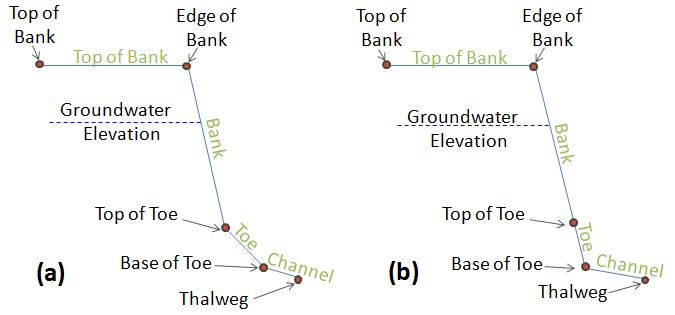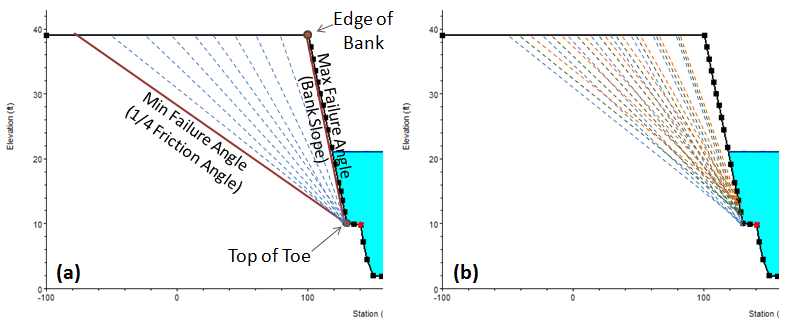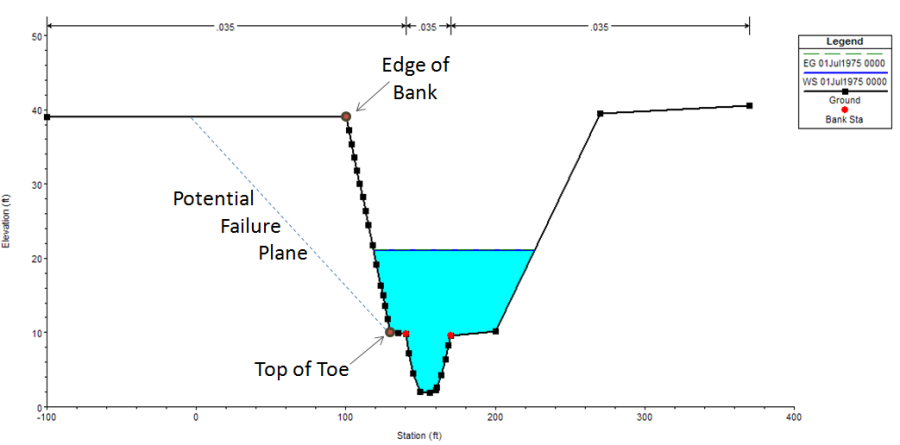Download PDF
Download page Defining Cross Section Configuration.
Defining Cross Section Configuration
Setting up HEC-RAS cross sections (for the left or right bank) in such a way that it is also compatible with BSTEM is an extremely important step in getting physically appropriate failures from the BSTEM computations. The conceptual BSTEM half cross section (below) is composed of four segments (green labels in the figure below) with unique slopes:

- The Top of Bank which is the relatively flat portion of the cross section above the bank.
- The Bank which is the steepest part of the cross section.
- The Toe which is a mild slope between the bank and the channel, presumably composed of blocks of material that have fallen and accumulated at the base of the bank and are protecting the toe or some sort of rip rap or toe protection.
- The Channel which is the region between the toe and the thalweg.
HEC-RAS divides a cross section at the thalweg and uses the station-elevation points to the left of the thalweg for the left BSTEM half-cross section and those to the right of the thalweg for the right BSTEM geometry. There are at least four important current considerations for setting up an HEC-RAS cross section to get good performance from the BSTEM routines.
- The Top of Bank point should be far enough to the left or right (depending on which bank is being modeled) of the Edge of Bank to accommodate the full range of possible failure slopes (below).
- HEC-RAS 5.0 with BSTEM works best if the Top of Bank is not the farthest node to the left or right and if there are no station-elevation points between the Top of Bank and the Edge of Bank.
- There should be a number of relatively evenly spaced points between the Edge of Bank and the Top of Toe. BSTEM starts its failure plane search method at each station.

- Elevation point between the Edge of Bank and the Top of Toe (below). The spacing of nodes between these points will affect the precision of the failure plane computations.
- HEC-RAS will automatically select the lowest station-elevation point in the cross section to be the Thalweg.
Each bank of each cross section being analyzed requires two user defined points, an Edge of Bank Station and a Top of Toe Station. Note that these points are defined by their station across the cross section, not their elevation. These points are depicted in Unusual Cross Section Shape and are entered on the HEC-RAS Sediment Data Editor below and are defined in the following.
The Variables are defined in the Table below
| Left Bank Edge Station | This should be the inflection point between the bank and the top of the bank. All failure planes considered will intersect the top of bank between the edge of bank and the first cross section station-elevation point. |
| Right Bank Edge Station | Analogous to the Left Bank Edge station, this should be the inflection point between the bank and the top of the bank on the left side of the cross section. All failure planes considered will intersect the top of bank between the edge of bank and the last cross section station-elevation point |
| Left Bank Toe Station | BSTEM divides the bank into two sections, the Bank and the Toe sections (see figures above). Conceptually, the toe is material composed of blocks of failed material or engineered toe protection. Therefore, failure planes are only computed through the bank surface above the Top of Toe. The Top of Toe often corresponds to a break in slope or material type but it does not have to. In future versions of BSTEM, users will be able to select a separate material type for the toe but in the first alpha version of BSTEM, the software adopts the material type of the bank or layer associated with the toe. This parameter can be automatically set to the HEC-RAS left bank station for every cross section that has Left Bank Material defined. From the HEC-RAS Sediment Data Editor (bottom figure in link), click Set Toe Station to Bank Stations and click the Set Toe Stations to Movable Bed Stations (movable bed limits). Setting movable bed limits and toe stations at the same node is recommended. |
| Right Bank Toe Station | The Right Bank Toe is analogous to the Left Bank Toe section and can be set to the right bank station for every bank that has Right Bank Material defined. From the HEC-RAS Sediment Data Editor (bottom figure of link), click Set Toe Station to Bank Stations and click the Set Toe Stations to Movable Bed Stations (movable bed limits). Setting movable bed limits and toe stations at the same node is recommended. |
| GW Elev | In order to compute bank failure on either side of any cross section a Groundwater Elevation must be specified. Results will be very sensitive to this parameter. BSTEM does not yet have a physical limit to negative pore water pressure so a very low groundwater table could generate nearly infinite bank stability. If the static groundwater option is selected, BSTEM will use this groundwater elevation for the entire cross section simulation. If the dynamic groundwater option is selected, the user specified groundwater elevation will become the initial elevation, and groundwater will rise and fall in response to the hydraulic conductivity. The overbank is modeled as a "reservoir" with a volume determined by the distance between cross sections and the user specified "Reservoir Width" parameter in the BSTEM material parameters, which the model moves between the groundwater reservoir and the channel at the rate of the user specified saturated hydraulic conductivity. |